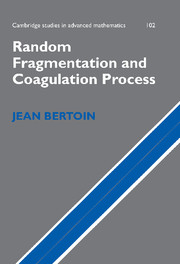3 - Exchangeable fragmentations
Published online by Cambridge University Press: 07 December 2009
Summary
We now resume the study of processes in continuous time that describe the evolution of a unit mass which breaks down randomly into pieces, in such a way that distinct components have independent and self-similar evolutions. The crucial point is that we now allow fragments to split immediately, a situation that could not be handled by the discrete techniques of Chapter 1.
We shall first focus on the homogeneous case when splitting rates are further assumed to be the same for every fragment. The framework of exchangeable random partitions, which has been developed in the preceding chapter, provides a powerful tool for the construction and the analysis of this special class of fragmentation processes. In particular, we shall specify their Poissonian structure and characterize their distributions in terms of an erosion coefficient and rates of sudden dislocations. We shall also point out an important relation between a randomly tagged fragment and a certain subordinator, extending our observations for the evolution of the randomly tagged branch in Chapter 1. Finally, we shall present a transformation of homogeneous fragmentations which enables us to construct general self-similar fragmentations (i.e. with splitting rates proportional to a power function of the mass).
Homogeneous fragmentation processes
We shall now investigate fragmentation processes in the framework of random exchangeable partitions. Let us briefly explain the intuition which will guide us, by presenting an important example that will be used several times to illustrate notions and results in this chapter.
- Type
- Chapter
- Information
- Random Fragmentation and Coagulation Processes , pp. 112 - 162Publisher: Cambridge University PressPrint publication year: 2006

